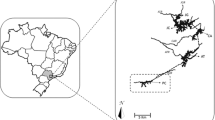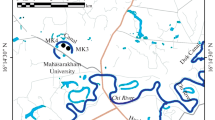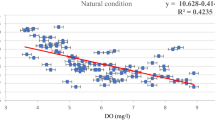Abstract
Laboratory bioassays consisting of sediments spiked with three concentrations (30, 130, and 260 μg g−1 As dry wt) of arsenic (As+3) were used to assess morphologic responses and growth in Chironomus tentans larvae. Chironomid larvae were raised in contaminated sediments from egg stage to emergence, and mouthpart abnormalities, larval length, and larval head width were used as end points to determine differences between metal-spiked and control specimens. C. tentans exhibited significantly higher mouthpart deformity proportions, smaller body sizes, smaller head widths, and slower development than control larvae. Our results demonstrate a dose–response relationship between As and mentum deformities in C. tentans. However, the proportion of deformed larvae did not increase with time in the treatment tanks. Results demonstrate that As induces mouthpart abnormalities at various concentrations. This research provides more support for the use of chironomid abnormalities as a tool for the assessment of heavy-metal pollution in aquatic systems.




Similar content being viewed by others
References
Benoit DA, Sibley. PK, Juenemann JL, Ankley GT (1997) Chironomus tentans life-cycle test: Design and evaluation for use in assessing toxicity of contaminated sediments. Environ Toxicol Chem 16:1165–1176
Bird GA, Rosentreter MJ, Schwartz WJ (1995) Deformities in the menta of chironomid larvae from the experimental lakes area, Ontario. Can J Fish Aquat Sci 52:2290–2295
Borgmann U, Cove R, Loveridge C (1980) Effects of metals on the biomass production kinetics of freshwater copepods. Can J Fish Aquat Sci 37:567–575
Burton GA J, Lazorchak LM, Waller WT, Lanza GR (1987) As toxicity changes in the presence of sediment. Bull Environ Contam Toxicol 38:491–499
Canton KP (1996) As in drinking water: How much is too much?. Epidemiology. 7:113–114
Dickmans M, Brindle I, Benson M (1992) Evidence of teratogens in sediments of the Niagara River watershed as reflected by chironomid (Diptera: Chironomidae) labial plate deformities. J Great Lakes Res 18:467–480
Dyer SA, Brooks GL, Dickson KJ, Sander BM, Zimmerman EG (1993) Synthesis and accumulation of stress proteins in tissues of arsenite-exposure fathead minnows (Pimephales promelas). Enviorn Toxicol Chem 12:913–924
Hansen LD, Maier KJ, Knight AW (1993) The effect of sulfate on the bioconcentration of selenate by Chironomus decorus and Daphnia magna. Arch Environ Contam Toxicol 25:72–78
Hudson LA, Ciborwski JJH (1996) Spatial and taxonomic variation in incidence of mouthpart deformities in midge larvae (Diptera: Chironomidae: Chironomini). Can J Fish Aquat Sci 53:297–304
Janssen de Bisthoven LG, Postma J, Vermeulen A, Goemans G, Ollevier F, (2001) Morphological deformities in Chironomus riparius Meigen larvae after exposure to cadmium over several generations. Water Air Soil Pollut 129:167–179
Janssens de Bisthoven L (1998) Relations between heavy metals in aquatic sediments and Chironomus larvae of Belgian Lowland rivers and their morphological deformities. Can J Fish Aquat Sci 55:688–703
Janssen de Bisthoven LG, Nuyts P, Goddeeris P, Ollevier F (1998) Sublethal parameters in morphologically deformed Chironomus larvae: Clues to understanding their bioindicator value. Fresh Biol 39:179–191
Janssens de Bisthoven LG, Huysmans C, Ollevier F (1994) The in situ relationships between sediment concentrations of micropollutants and morphological deformities in Chironomus gr. thunmmi larvae (Diptera, Chironomidae) from low land rivers (Belgium) a spatial comparison. In: Cranston P (ed) Chironomids: From genes to ecosystems. East Melbourne, Austrila CSIRO, pp 63–80
Janssens de Bisthoven LG, Timmermans KR, Ollevier G (1992) The concentration of cadmium, lead, copper, and zinc in Chironomus gr. thummi larvae (Diptera: Chironomidae) with deformed versus normal menta. Hydrobiologia 239:141–149
Köhn T, Frank C (1980) Effect of thermal pollution of the chironomid fauna in an urban channel In: Murray (ed) Chironomidae: Ecology, systematics, cytology, and physiology. New York, NY, Pergamon pp. 187–194
Kosalwat P, Knight AW, (1987) Chronic toxicity of copper to a partial life cycle of the midge. Chironomus decorus. Arch Environ Contam Toxicol 16:283–290
Krantzberg G, Stokes PM (1989) Metal regulation, tolerance, and body burdens in larvae of the genus Chironomus. Can J Fish Aquat Sci 46:389–398
Larsson P (1984) Transport of PCSs from aquatic to terrestrial environments by emerging chironomids. Environ Pollut 34:283–289
Liber K, Call DJ, Dwason TD, Whiteman FW, Dillon TM (1996) Effects of Chironomus tentans larval growth and retardation on adult emergence and ovipositing success: Implications for interpreting freshwater sediment. Hydrobiologia 323:155–167
Lima AR, Curtis C, Hammermeister DE, Markee TP, Northcott CE, Brooke LT (1984) Acute and chronic toxicities of As (III) to fathead minnows, flagfish, daphnids and an amphipod. Arch Environ Contam Toxicol 13:595–601
Martinez EA, Moore BC, Schaumloffel J, Dasgupta N (2001) Induction of morphological deformities in Chironomus tentans exposed to zinc and lead spiked sediments. Environ Toxicol Chem 20:2475–2481
Martinez EA, Moore BC, Schaumloffel J, Dasgupta N (2002) The potential association between menta deforaiities and trace elements in Chironomidae (Diptera) taken from a heavy metal contaminated river. Arch Environ Contain Toxicol 42:286–921
Martinez EA, Moore B, Schaumloffel J, Dasgupta N (2003) Morphological abnormalities in Chironomus tentans exposed to cadmium and copper spiked sediments. Ecotox Environ Safe 55:204–212
Martinez EA, Moore B, Schaumloffel J, Dasgupta N (2004) Effects of exposure to a combination of zinc and lead spiked sediments on mouthpart development and growth in Chironomus tentans (Diptera; Chironomidae). Environ Toxicol Chem 23:662–667
Meregali G, Pluymers L, Ollevier F (2001) Induction of mouthpart deformities in Chironomus riparius larvae exposed to 4-n-nonylphenol. Environ Pollut 111:241–246
Nriagu JS (1984) Changing Metal Cycles and Human Health. Springer, Berlin. pp 241–248
Pascoe D, Kendall AW, Green DWJ (1989) Chronic toxicity of cadmium to Chironomus riparius Meigen. Effects upon larval development and adult emergence. Hydrobiologia 175:109–157
Passino DRM, Novak AJ (1984) Toxicity of arsenate and DDT to the cladoceran Bosmina longirostris. Bull Environ Contam Toxicol 33:325–329
Postma JF, Davids C (1995) Tolerance, induction, and life cycle changes in cadmium exposed Chironomus riparius (Diptera, Chironomidae). Hydrobiologia 315:159–169
Reynoldson TB (1987) Interactions between sediments contaminants and benthic organisms. Hydrobiologia 149:53–66
Sanders HO (1979) Effects of arsenic speciation and phosphate concentration on arsenic inhibition of Skeletonema costatum (Bacillariophyceae). J Phycol 15:424–428
SAS (1985) SAS/STAT users’ guide, version 6.03. Cary, NC, SAS Institue
Sibley PK, Benoit DA, Ankley GT (1997) The significance of growth in Chironomus tentans sediment toxicity tests: Relationship to production and demographic endpoints. Environ Toxicol Chem 16:336–345
Tseng CH, Chong CK, Chen CJ, Tai TY (1997) Lipid profile and peripheral vascular disease in arseniasis-hyperendemic villages in Taiwan. J Vascular Dis 48:321–335
United States Enviornmental Protection Agency (2000) Methods for measuring the toxicity and bioaccumulation of sediment-associated contaminants with freshwater invertebrates. EPA 600/R-94/024. Washington, DC
Vermeulen AC (1995) Elaborating chironomid deformities as bioindicators of toxic sediment stress: The potential application of mixture toxicity concepts. Ann Zool Fennici 32:265–285
Warwick WF (1985) Morphological abnormalities in Chironomidae (Diptera) larvae as biological indicators of toxic stress in freshwater ecosystems: Indexing antennal deformities in Chironomus Meigen. Can J Fish Aquat. Sci 42:1881–1914
Warwick WF (1990) The use of morphological deformities in chironomid larvae for biological effects monitoring. Sci Ser Inland Water/Lands Dir Can 173: 1–34
Williams KA, Green DWJ, Pascoe D, Gower GE (1986) The acute toxicity of cadmium to different larval stages of Chironomus riparius (Diptera: Chironomidae) and its ecological significance for pollution regulation. Oecologia 70:362–366
Acknowledgment
This research was funded by the EPA Exploratory Biology Program (R826106).
Author information
Authors and Affiliations
Corresponding author
Rights and permissions
About this article
Cite this article
Martinez, E.A., Wold, L., Moore, B.C. et al. Morphologic and Growth Responses in Chironomus tentans to Arsenic Exposure. Arch Environ Contam Toxicol 51, 529–536 (2006). https://doi.org/10.1007/s00244-005-0308-0
Received:
Accepted:
Published:
Issue Date:
DOI: https://doi.org/10.1007/s00244-005-0308-0




